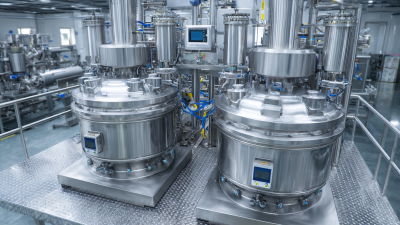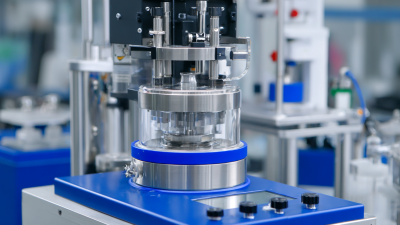In the quest for enhancing product quality across various industries, the significance of advanced technology in homogenization cannot be overstated.
 High Pressure Valve Homogenizers play a pivotal role in achieving superior product consistency and stability, making them essential tools for manufacturers aiming to push the boundaries of innovation.
At CAS PETER (HANGZHOU) NANOTECHNOLOGY CO., LTD, we are dedicated to providing cutting-edge nanotechnology solutions, focusing on the research and sales of high pressure homogenizers and microfluidizers.
Our expertise allows us to meet the diverse homogenization needs of different sectors, leveraging the power of High Pressure Valve Homogenizers to improve product quality effectively.
This guide will illuminate how embracing advanced homogenization technology can lead to significant improvements in product performance, ensuring that our clients stay ahead in a competitive market.
High Pressure Valve Homogenizers play a pivotal role in achieving superior product consistency and stability, making them essential tools for manufacturers aiming to push the boundaries of innovation.
At CAS PETER (HANGZHOU) NANOTECHNOLOGY CO., LTD, we are dedicated to providing cutting-edge nanotechnology solutions, focusing on the research and sales of high pressure homogenizers and microfluidizers.
Our expertise allows us to meet the diverse homogenization needs of different sectors, leveraging the power of High Pressure Valve Homogenizers to improve product quality effectively.
This guide will illuminate how embracing advanced homogenization technology can lead to significant improvements in product performance, ensuring that our clients stay ahead in a competitive market.
High pressure valve homogenizers play a critical role in enhancing product quality across various industries, including food and beverage, pharmaceuticals, and cosmetics. According to a report by MarketsandMarkets, the global homogenizers market is expected to grow from USD 2.3 billion in 2020 to USD 3.4 billion by 2025, reflecting a keen interest in technologies that ensure consistency and quality in products. The sophisticated mechanism of high pressure valve homogenizers allows for the efficient reduction of particle size, which not only improves texture and mouthfeel but also enhances the bioavailability of active ingredients in pharmaceutical applications.
The effectiveness of these homogenizers is underscored by their ability to create stable emulsions and suspensions. A study conducted by the Journal of Food Engineering indicates that high pressure homogenization can reduce droplet sizes to less than one micron, resulting in more uniform distribution of ingredients and better stability of emulsions. This precision translates into improved product quality and customer satisfaction, with consumers increasingly seeking products that offer enhanced sensory characteristics and health benefits. Thus, deploying advanced high pressure valve homogenizers becomes essential for manufacturers aiming to meet evolving market demands and regulatory standards.
High pressure valve homogenizers are revolutionizing the way industries improve product quality by leveraging advanced technologies. One of the key technologies driving this change is the use of smart control systems that optimize the homogenization process. According to a report by the International Society for Pharmaceutical Engineering, businesses employing advanced homogenization technologies have seen efficiency increases by up to 30%. This is largely due to enhanced monitoring and real-time adjustments that minimize inconsistencies in product quality.
Another critical technology is the integration of energy-efficient designs. Modern high pressure valve homogenizers are now constructed with materials that reduce energy consumption while maintaining output quality. A study by the Food Processing Technology Journal indicates that companies adopting these designs have reduced operational costs by approximately 20%, making it easier to achieve sustainability goals alongside quality improvements.
Tips: When implementing high pressure homogenizers, consider investing in a system with advanced monitoring capabilities. This allows for precise control of pressure and flow rates, leading to consistent product results. Additionally, choosing energy-efficient equipment not only benefits the environment but also improves your bottom line.
Implementing homogenization in your production process can significantly enhance product quality, especially when utilizing high pressure valve homogenizers. These advanced devices ensure uniform particle size and consistency, making them indispensable in industries such as food and beverage, pharmaceuticals, and cosmetics. To start, assessing your current production workflow is crucial. Identify key areas where homogenization can be most beneficial, and choose the appropriate high pressure valve homogenizer that suits your specific product requirements.
**Tips:** Always consider the viscosity of your product; different substances may require different homogenization techniques. Regular maintenance of your homogenizer is essential to prevent wear and ensure optimal performance. Moreover, conducting small-scale trials before full-scale implementation can help fine-tune the process and highlight any potential issues.
Training your staff on the operation and benefits of homogenization is also vital. A well-informed team can better monitor the process, ensuring that product specifications are consistently met. In addition, keep track of data and quality control metrics to assess the effectiveness of the homogenization in improving product quality, which will provide insights for continuous improvement in your production line.
This chart illustrates the relationship between the use of high pressure valve homogenizers and the resulting product quality across different production stages. The data reflects quality scores (on a scale of 1 to 10) before and after implementing homogenization technology.
 Homogenizers have revolutionized various industries by enhancing product quality through advanced high-pressure valve technology. In sectors such as food and beverage, cosmetics, and pharmaceuticals, these machines play a critical role in achieving consistent texture, improved emulsification, and better overall stability of products. For instance, in the food industry, homogenizers ensure uniform distribution of ingredients, which not only optimizes taste and mouthfeel but also extends shelf life by reducing the risk of separation and spoilage.
Homogenizers have revolutionized various industries by enhancing product quality through advanced high-pressure valve technology. In sectors such as food and beverage, cosmetics, and pharmaceuticals, these machines play a critical role in achieving consistent texture, improved emulsification, and better overall stability of products. For instance, in the food industry, homogenizers ensure uniform distribution of ingredients, which not only optimizes taste and mouthfeel but also extends shelf life by reducing the risk of separation and spoilage.
In the pharmaceutical industry, the role of homogenizers is equally significant. They facilitate the creation of uniform emulsions and suspensions, which are vital for effective drug delivery. By using advanced homogenization techniques, manufacturers can produce higher-quality formulations with improved bioavailability and efficacy. Evaluating the advancements brought by homogenizers reveals a marked improvement in product performance across diverse applications, ultimately leading to enhanced customer satisfaction and loyalty. This technological evolution underscores the importance of quality assurance in maintaining competitive advantages within these industries.
 When utilizing high pressure valve homogenizers, it's essential to address common issues that could impact their performance. One frequent problem is inconsistent product texture, which may stem from improper valve settings. Ensuring the pressure is correctly calibrated can significantly enhance the uniformity of your product. Regularly check the homogenization pressure and adjust it according to the specific material properties to achieve optimal results.
When utilizing high pressure valve homogenizers, it's essential to address common issues that could impact their performance. One frequent problem is inconsistent product texture, which may stem from improper valve settings. Ensuring the pressure is correctly calibrated can significantly enhance the uniformity of your product. Regularly check the homogenization pressure and adjust it according to the specific material properties to achieve optimal results.
Another common challenge is wear and tear on the valve components, which can lead to inefficient processing. To prevent this, implement a routine maintenance schedule. Regular inspections and timely replacements of worn-out parts can help maintain efficiency and prolong the lifespan of the homogenizer.
Tips: Always keep a log of your homogenizer's performance metrics; this can help you identify patterns related to issues that arise. Additionally, consider training your operators on troubleshooting techniques to quickly resolve minor issues before they escalate into significant downtime.
: Homogenization significantly enhances product quality by ensuring uniform particle size and consistency, making it essential in industries like food and beverage, pharmaceuticals, and cosmetics.
Assess your current production workflow to pinpoint key areas where homogenization could be most beneficial, considering your specific product requirements.
Regular maintenance prevents wear and ensures optimal performance, which is crucial for consistent product quality.
Different substances may require different homogenization techniques, so understanding the viscosity of your product is important to choose the appropriate method.
Conducting small-scale trials before full-scale implementation allows you to fine-tune the process and identify potential issues, ensuring smoother operations later on.
A well-informed team can better monitor the process, ensuring that product specifications are consistently met, which directly impacts product quality.
Common issues include inconsistent product texture due to improper valve settings and wear and tear on valve components affecting processing efficiency.
Implementing a routine maintenance schedule, including regular inspections and timely replacements of worn-out parts, can help maintain efficiency and prolong the homogenizer's lifespan.
Keep track of data and quality control metrics to evaluate how homogenization improves product quality, which aids in continuous improvement.
Training operators on troubleshooting techniques can enable them to quickly resolve minor issues before they escalate into significant downtime.
High Pressure Valve Homogenizers play a crucial role in enhancing product quality across various industries by enabling efficient homogenization processes. By utilizing advanced technologies, these homogenizers can significantly improve the uniformity and stability of products, leading to better performance and customer satisfaction. The article outlines key practices for implementing homogenization effectively in production, ensuring optimal results and addressing common issues that may arise during operation.
CAS PETER (HANGZHOU) NANOTECHNOLOGY CO., LTD specializes in high pressure homogenization solutions, offering innovative products tailored to meet the diverse needs of various sectors. Their focus on research and development ensures that clients benefit from cutting-edge technology that enhances both product quality and production efficiency through the effective use of High Pressure Valve Homogenizers.







